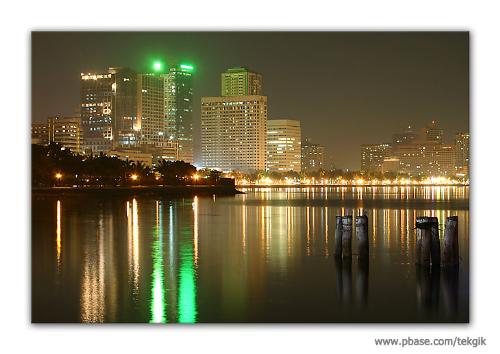Man from Manila
By greenmango
@greenmango (1019)
Philippines
December 18, 2006 4:18pm CST
The 'Pearl of the Orient' in the quiet days of Spanish rule, Manila now lets its core of grit show. The city is located on the west coast of the Philippine main island of Luzon and surrounded by fertile plains. The city straddles the delta of the Pasig River, a short navigable stream that connects the freshwater lake of Laguna de Bay with the huge natural harbour of Manila Bay and the South China Sea. Hot and humid throughout the year, Manila's climate is slightly tempered by the sea breezes. Typhoons sometimes occur in May and November.
Originally Manila was a conglomeration of 17 towns and villages, which were brought together under the regime of President Marcos in 1976. Metro Manila is the actual urban core, based around the colonial capital of Intramuros and the other districts of Ermita, Malate, Quipao, San Nicolas, Paco and Binondo. The 38 sq km (15 sq miles) of urban sprawl extends to outlying towns and villages such as Quezon City, Pasay City, Pasig City and Makati City, the centre for business and much of the nightlife.
Historically, Manila Bay's topography and strategic location, between the Old World's silk and spices on the one side and the New World's silver on the other, favoured commerce and made the bay a natural magnet for maritime traders. The Chinese were the first foreigners to arrive and trade in the islands in 98AD but by the late 15th century, the restless Europeans had sent Ferdinand Magellan westward to the Philippines. He landed in 1521 and claimed the islands for Spain, which took over Manila (called Maynilad by early Muslim settlers) in 1571.
Despite a revolution and proclamation of independence, the Philippines fell to the United States of America, following the 1898 collapse of the Spanish Empire. In 1935, the USA approved the Commonwealth of the Philippines, only for it to be crushed by the Japanese invasion in 1941. After a bitter rearguard action around Manila, the American and Philippine forces finally surrendered in 1942 but managed to recapture Manila two years later, in a series of ferocious land and naval battles that left it ruined and depopulated.
The Filipinos gained independence in 1946. However, following the 1965 election of Ferdinand Marcos, anti-government riots gave him the pretext to declare martial law in 1972, inaugurating perhaps the most kitsch tyranny on record, ably assisted by his wife (and governor of Metro Manila), Imelda Marcos. The brutal absurdities of their regime continued until 1986, when 'People Power' and the defection of key supporters drove them into well-heeled exile. Subsequent democratic administrations have improved the image and politics of the Philippines, however, not its economy.
Manila today is a sprawling chaotic agglomeration that exercises a disproportionate influence on the entire country and is a lesson in contrasts. The dichotomies of wealth and poverty are evident, with the palatial neighbourhoods around Makati contrasting with squatter camps along the river, where the destitute scavenge to survive. So much of Manila still remains mired in the Third World and democracy has brought little change as yet to the poor. The city's chaos also reflects the Philippines' cultural diversity – there are more than a hundred cultural minority groups living in the country.
Manila is an overpowering city and can certainly prove to be hectic if you are not prepared for it. A combination of the bustle of the traffic, noise, pollution, poverty and often-shabby infrastructure makes the city seem intimidating. However, Manila's energy and the good humour of its people become infectious.
3 responses






